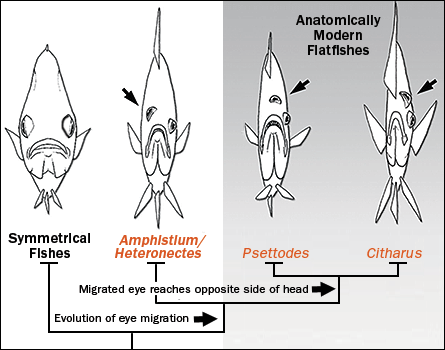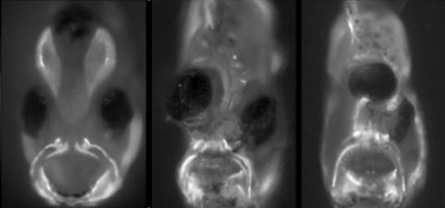A wandering eye
Fossils show middle stage of the evolution of flatfish eyes to one side of their head
- More than 2 years ago
A new look at the fossils of primitive flatfish offer evidence that these fish — well-known for having both eyes on one side of their head — started out symmetrical and gradually evolved their one-sided trait.


Evolutionary biologists have floundered to explain how bottom-dwelling, carnivorous flatfish, such as flounder and plaice, evolved to have both eyes on one side of their head. Previous analyses of fossil evidence concluded that the change was abrupt. But reexamination of ancient fossils now supports the hypothesis that the flatfish eye position actually evolved over thousands to millions of years. The findings appear in the July 9 Nature.
Fossil evidence had already shown that flatfish ancestors had one eye on each side of the head. But no evidence had existed for a transition between a symmetrical skull and one-sided skull. Matt Friedman, a graduate student at the University of Chicago, looked more closely at 45-million-year-old fossils of primitive flatfish and found the transition species: One eye had moved, but it had not crossed the midline of the fish’s body, as seen in today’s flatfish, Friedman reports.
The fossils, Friedman says, deliver a clear picture of how this flatfish group changed from a standard fish with eyes on both sides to one with eyes on only one side of the head.
The flatfish eyes and skeletal structure underwent small, incremental changes, says Alex Schreiber, a developmental biologist who studies flatfish at St. Lawrence University in Canton, N.Y., and was not involved in the study. The fishes’ evolution was, in essence, gradual, he says.
Darwin and his contemporaries began the debate as to how flatfish eyes evolved, arguing either for gradual evolution, as Darwin did, or for evolution by punctuated leaps.
By presenting “unambiguous evidence” for the gradual change, Friedman now takes that debate into the 21st century, says paleontologist Philippe Janvier of the Muséum National d’Histoire Naturelle in Paris, France, who was not involved in the research.
Watch flatfish development:
This video shows the development of a flatfish from its juvenile to adult stage. Near the end, the fish’s eyes appear together on one side of its head. The stages of development of one flatfish essentially mirror the evolutionary history of adult flatfish morphology.
This video shows the skeletal changes that a flatfish goes through as it develops into an adult fish. The eye socket in the fish’s skull actually grows toward the other eye socket and, in the end, the fish has both eyes on one side of its head. Both videos are courtesy of Alex Schreiber, the Carnegie Institute of Washington and St. Lawrence University in Canton, N.Y.







